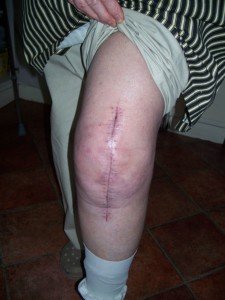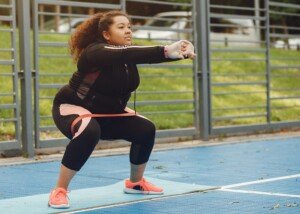
Are you now fully recovered from your total knee replacement surgery and are interested in taking up jogging for aerobic exercise?
There is a strong likelihood that you, as a total knee replacement patient, were not a runner or jogger in the few years prior to the surgery.
By the time a TKR is needed, the joint is bone on bone or almost such, and the patient is suffering from considerable pain; even slow walking is very painful.
Perhaps many years ago you were into jogging, and now you want to get back into it.
Or maybe you’ve never been a jogger, much less runner, and are now considering taking up this form of cardio exercise.
However, as a total knee replacement patient, running—and even jogging—is off-limits to you.
Why Total Knee Replacement Patients Should Never Run or Even Jog for Exercise

Credit: Dave Haygarth
“I would never recommend that anyone (previous runner or not) who has had a TKR take up running, unless it is to run from someone for your life,” says Barbara Bergin, MD, board certified orthopedic surgeon at and co-founder of Texas Orthopedics, Sports & Rehabilitation Associates.
Dr. Bergin explains, “Many surgeons who do TKR’s don’t like to give patients any doubts regarding their knee replacements, so they often tell patients they can do anything they want to after surgery, like run, play sports and ski.
“If they tell you that you can’t do these things, patients often wonder why they would want to have the surgery if they can’t resume the things they used to do or the things they think they might like to do.
“They will have doubts about the integrity of the operation and the skill of the surgeon. So the surgeon just says ‘yes.’
“As a surgeon who used to do total joint replacements, I can tell you that I always told my patients ‘no.’
“And here’s why. You have only one chance to have one total joint (per joint). They last about 20 years before they loosen and wear out.
“This stat includes all comers, from 45-year-old, morbidly obese patients to 100 lb., 80-year-old ladies.
“If you have your total knee replacement when you’re 60, and it wears out when you’re 80, you are now faced with a revision.
“Revision joint replacement is a salvage operation. It is more complicated. More bone must be removed. You are more likely to have a fracture or an infection. You are more likely to be dissatisfied.
“Your surgeon assumes, if you’re older, that you aren’t going to go out and tear it up, so they say ‘yes.’
“But younger patients are more likely to get more active. This is why they are more likely to wear the total knee replacement out sooner and are more likely to be dissatisfied with the result.”
- The artificial joint includes polyethylene bearings.
- Running would place tremendous stress on these components which could lead to a disastrous failure of the polyethylene material.
Exercises that a TKR Patient Can Do
Dr. Bergin explains, “Take care of your total knee or hip replacement like it was your child. Don’t do high impact exercises. Don’t do squats. Don’t play sports.
“What can you do? Walk, swim, cycle, play golf, travel and just live without pain. That’s the actual reason to do a total knee replacement: to decrease pain.
“It’s not to allow you to do more activities, unless it’s just the activities of normal living.”
Don’t even think about skiing or racquetball, though light tennis is approved by the American Academy of Orthopedic Surgeons.
Yoga is also permitted, but do not sit on your heels and avoid squat-like poses or positions that involve considerable knee bending (e.g., child’s pose). There are plenty of yoga poses that are safe for an artificial knee joint.
“And a word to the wise,” adds Dr. Bergin. “Patients who are overweight often think that they need that knee replacement in order to exercise and lose weight.
“Warning: Studies show that pretty much no one loses weight after having a total joint replacement. And that’s because weight loss occurs in the kitchen and not out on the running track.”
Walk, Don’t Run, with a Total Knee Replacement

Shutterstock/ Dmytro Zinkevych
Proper biomechanics when walking are crucial for those with a TKR. Though walking outdoors is better for the joints than is using a treadmill, the treadmill is often a more convenient option.
Once you are completely recovered from your TKR, you should not hold onto the treadmill, as this will disrupt the body’s natural gait.
Or, to get a bit jargony, it will mess up the kinetic chain. This is the last thing a knee joint – artificial or natural – needs.
Holding on will force your body to assume improper posture while walking. There is no reason for continuously holding onto the treadmill and making the holding-on part of the workout.
Hold on while sipping water or taking a heart rate check, but then walk with your arms swinging naturally, the way the body is supposed to move.
If your knee hurts, this will not be corrected by holding onto the treadmill.
If you feel you’ll lose balance without holding on, then you’re going too fast, even if you think the speed is slow. It can always be slower.
Walking on a treadmill without holding on encourages good posture and proper knee movement because your body is forced to balance and walk correctly—the way nature intended it to.
The total knee replacement patient does not need to go running to get an effective cardiovascular workout.













